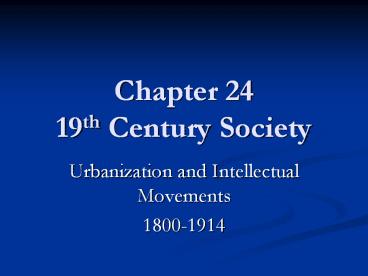Chapter 24 19th Century Society - PowerPoint PPT Presentation
Title: Chapter 24 19th Century Society
1
Chapter 2419th Century Society
- Urbanization and Intellectual Movements
- 1800-1914
2
First Industrial Revolution
- 1780-1850
- Textiles
- Coal
- Iron
- Railroads
3
Second Industrial Revolution
- Last half of the 19th century
- Steel Production heavy machinery, rails, larger
structures - Oil kerosene for lighting, internal combustion
engines for factory machines - Electricity
- 1881 England first electric power stations
- Steel, textiles, shoemaking and construction
industries - Chemicals Photo processing, soaps, dyes,
fertilizers, explosives (Germany first)
4
Growing Demand for Experts with specialized
knowledge
- Science and technology became linked
- New Professionals Engineers, architecture,
chemistry, accounting, surveying - Managers for large private and public
institutions
5
By 1890s Germany the Industrial Leader
- Englands early investment in technology made it
difficult to shift to new techniques of 2nd
Industrial Revolution - Germanys late enterence allowed it to enter with
state-of-the-art technology - Germany led in production of organic chemicals
and power generators
6
Continued Urban Migration
- By 1900 over half of industrial workers in
England, Germany, and Belgium worked for
companies with more than 20 workers
7
Urbanization
- Population Growth
- England the first to experience urban growth
- 1891 over 50 of population in urban areas
- 1891 London largest city in Europe
- 1870-1914 Population in Europe up 50
- By 1900 9 European cities had 1 million
- Big decline in mortality rates (especially
children) - Birth rates fell in some areas (France)
8
Population continued
- Better medical knowledge, nutrition, housing
- Number of children per family fellespecially
among the middle class
9
Poor living conditions continued
- Through first ½ of 19th century
- Parks and open spaces nonexistent
- 10 people per room in cellars, attics
- Open drains and sewers flowed through the streets
with garbage, excrement - Total absence of public transportation
10
Public Health Movement
- Edwin Chadwick The most important reformer of
living conditions in cities - Tried to end high incidence of disease and
mortality rate occurring in cities - Saw disease and death as CAUSES of poverty
- Was influenced by Jeremy Benthams Utilitarianism
11
Edwin Chadwick continued
- Sanitary Idea believed disease could be
prevented by cleaning up urban environment - Adequate supply of cleaned piped water could
carry off excrement of communal outhouses - Would cost only 1/20 of removing it by hand
12
Public Health Laws
- 1848 England First public health law
- Due to the Cholera epidemic of early 1830s
- Germany, France and U.S. adopted many of
Chadwicks ideas - By 1860s and 70s many European cities made
progress in public sanitation
13
Urban Planning and Public Transportation
- France first under reign of Napoleon III
- Georges von Haussmann redeveloped Paris
- Wide Boulevards (would also prevent barricades)
- Better middle-class housing on citys outskirts
- Demolition of slums
- Creation of parks, open spaces
14
Urban Planning continued
- New system of aqueducts doubled fresh water
supply - 400 miles of underground sewers were built
- In response to cholera epidemics of 1832 and 1849
- Vienna, Cologne, and other cities followed Paris
lead
15
Mass Transportation
- By 1890s The electric streetcar revolutionized
public transportation - Created suburbs on the outskirts of cities
- Electricity led to the creation of Londons
subway system in the 1860s - Paris had the Metro by 1900
- By 1900 only 9 of Englands population was
overcrowded (now more than 2 per room)
16
Migration and Immigration
- Migration to the cities from the countryside
continued BUT now migrants maintained ties to
rural areas - After 1880 huge numbers of southern and eastern
Europeans migrated to America for economic
opportunities - Also went to Canada and Latin America
- In some places agricultural challenges forced
migration
17
Eastern European Jews
- Pogroms, other persecution in eastern Europe
forced Jewish population to flee - To Western Europe
- To U.S., Canada, Latin America































